Fatigue Performance and Model of Polyacrylonitrile Fiber Reinforced Asphalt Mixture
Abstract
:1. Introduction
2. Materials
3. Specimen Preparation and Test Procedure
4. Test Results and Discussion
- As seen from Table 4, the optimum asphalt content of 0.3% fiber content in the asphalt mixture increased by nearly 8% compared to that without fiber. The total surface area of aggregates is basically equal for the same gradation aggregates. This means that the thickness of the asphalt film around aggregates increases by nearly 8%, which is beneficial to the fatigue life of the asphalt mixture;
- On the one hand, the physical and chemical reactions occur on the interface between the asphalt and fiber; on the other hand, the asphalt mortar with a higher viscosity is formed after the addition of fibers. Therefore, the thickness of the structural asphalt film on the aggregate surface and the toughness of the asphalt, as well as the adhesive force to the aggregate, has been increased, which will help to improve the adhesive capacity between the aggregate and asphalt;
- A large number of fibers distributed randomly in three dimensions and evenly formed net-like structures in the mixture, which inhibited the appearance and propagation of cracks, as shown in Figure 8. The healing of cracks of asphalt pavement by themselves is enhanced and the occurrence of cracks is postponed. The reinforced role is similar to the traditional mortar mixed with short straws;
- With the mixture fiber content increasing, the aforesaid reinforced action will be more frequent and the fatigue life will be improved; and
- It also can be seen from Figure 8c, when the amount of fiber is excessive (above the optimum content), the redundant “free fibers” will appear in the mixture. Those “free fibers” even agglomerate somewhere. These “free fibers” and agglomerated fibers will weaken the cohesion between the asphalt and aggregate. It leads to a decrease of the fatigue life of the mixture.
5. The Fatigue Model of Fiber Reinforced Asphalt Mixture
6. Conclusions
Author Contributions
Funding
Conflicts of Interest
References
- Pronk, A.C. Comparison of 2 and 4 point fatigue tests and healing in a 4 point dynamic bending test based on the dissipated energy concept. In Proceedings of the 8th International Conference on Asphalt Pavements, Seattle, DC, USA, 10–14 August 1997; pp. 986–994. [Google Scholar]
- Zheng, J.; Zhou, Z.; Zhang, Q. Design Theory and Methodology for Reducing Asphalt Pavement Cracks; People Communications Press: Beijing, China, 2003; ISBN 7-114-045913. [Google Scholar]
- Chen, X.; Li, N.; Hu, C.; Zhang, Z. Mechanical performance of fibers-reinforced asphalt mixture. J. Chang. Univ. (Nat. Sci. Ed.) 2004, 24, 1–6. [Google Scholar]
- Reed, B.F.; James, L.B. Polyester fibers in asphalt paving mixtures. AAPT 1996, 65, 387–409. [Google Scholar]
- Chen, H.; Xu, Q. Experimental study of fibers in stabilizing and reinforcing asphalt binder. Fuel 2010, 89, 1616–1622. [Google Scholar] [CrossRef]
- Ge, Z.; Wang, H.; Zhang, Q.; Xiong, C. Glass fiber reinforced asphalt membrane for interlayer bonding between asphalt overlay and concrete pavement. Constr. Build. Mater. 2015, 101, 918–925. [Google Scholar] [CrossRef]
- Kim, M.-J.; Kim, S.; Yoo, D.-Y.; Shin, H.-O. Enhancing mechanical properties of asphalt concrete using synthetic fibers. Constr. Build. Mater. 2018, 178, 233–243. [Google Scholar] [CrossRef]
- Xiang, Y.; Xie, Y.; Long, G. Effect of basalt fiber surface silane coupling agent coating on fiber-reinforced asphalt From macro-mechanical performance to micro-interfacial mechanism. Constr. Build. Mater. 2018, 179, 107–116. [Google Scholar] [CrossRef]
- Morea, F.; Zerbino, R. Improvement of asphalt mixture performance with glass macro-fibers. Constr. Build. Mater. 2018, 164, 113–120. [Google Scholar] [CrossRef]
- Klinsky, L.M.G.; Kaloush, K.E.; Faria, V.C.; Bardini, V.S.S. Performance characteristics of fiber modified hot mix asphalt. Constr. Build. Mater. 2018, 176, 747–752. [Google Scholar] [CrossRef]
- Sheng, Y.; Zhang, B.; Yan, Y.; Chen, H.; Xiong, R.; Geng, J. Effects of phosphorus slag powder and polyester fiber on performance characteristics of asphalt binders and resultant mixtures. Constr. Build. Mater. 2017, 141, 289–295. [Google Scholar] [CrossRef]
- Davar, A.; Tanzadeh, J.; Fadaee, O. Experimental evaluation of the basalt fibers and diatomite powder compound on enhanced fatigue life and tensile strength of hot mix asphalt at low temperatures. Constr. Build. Mater. 2017, 153, 238–246. [Google Scholar] [CrossRef]
- Dehghan, Z.; Modarres, A. Evaluating the fatigue properties of hot mix asphalt reinforced by recycled PET fibers using 4-point bending test. Constr. Build. Mater. 2017, 139, 384–393. [Google Scholar] [CrossRef]
- Badeli, S.; Carter, A.; Doré, G.; Saliani, S. Evaluation of the durability and the performance of an asphalt mix involving Aramid Pulp Fiber (APF) Complex modulus before and after freeze-thaw cycles, fatigue, and TSRST tests. Constr. Build. Mater. 2018, 174, 60–71. [Google Scholar] [CrossRef]
- Brovelli, C.; Crispino, M.; Pais, J.C.; Pereira, P.A.A. Assessment of Fatigue Resistance of Additivated Asphalt Concrete Incorporating Fibers and Polymers. J. Mater. Civ. Eng. 2014, 26, 554–558. [Google Scholar] [CrossRef] [Green Version]
- Guo, Q.; Li, L.; Cheng, Y.; Jiao, Y.; Xu, C. Laboratory evaluation on performance of diatomite and glass fiber compound modified asphalt mixture. Mater. Des. 2015, 66, 51–59. [Google Scholar] [CrossRef]
- Monismith, C.L.; Deacon, J.A. Fatigue of asphalt paving mixtures. Transp. Eng. J. 1969, 95, 317–346. [Google Scholar]
- Strategic Highway Research Program (SHRP). Fatigue Response of Asphalt-Aggregate Mixes; SHRP-A-404; National Research Council: Washington, DC, USA, 1994. [Google Scholar]
- Hajj, E.Y.; Sebaaly, P.E.; Weitzel, D. Fatigue characteristics of Superpave and Hveem mixtures. J. Transp. Eng. 2005, 131, 302–310. [Google Scholar] [CrossRef]
- Shen, S.; Carpenter, S.H. Application of the dissipated energy concept in fatigue endurance limit testing. J. Transp. Res. Board 2005, 1929, 165–173. [Google Scholar] [CrossRef]
- Ge, Z.; Huang, X. Study on asphalt mixtures fatigue properties by testing. J. Traffic Transp. Eng. 2002, 2, 34–37. [Google Scholar]
- Monismith, C.L.; Epps, J.A.; Finn, F.N. Improved asphalt mix design. J. Assoc. Asphalt Paving Technol. 1985, 54, 347–391. [Google Scholar]
- Pell, P.S.; Cooper, K.E. The effect of testing and mix variables on the fatigue performance of bituminous materials. J. Assoc. Asphalt Paving Technol. 1975, 44, 1–37. [Google Scholar]
- JTG F40-2004. In The Chinese Technical Specifications for Construction of Highway Asphalt Pavements; Renmin Communication Press: Beijing, China, 2004.
- JTG E20-2011. In The Chinese Standard Test Methods of Bitumen and Bituminous Mixtures for Highway Engineering; Renmin Communication Press: Beijing, China, 2011.

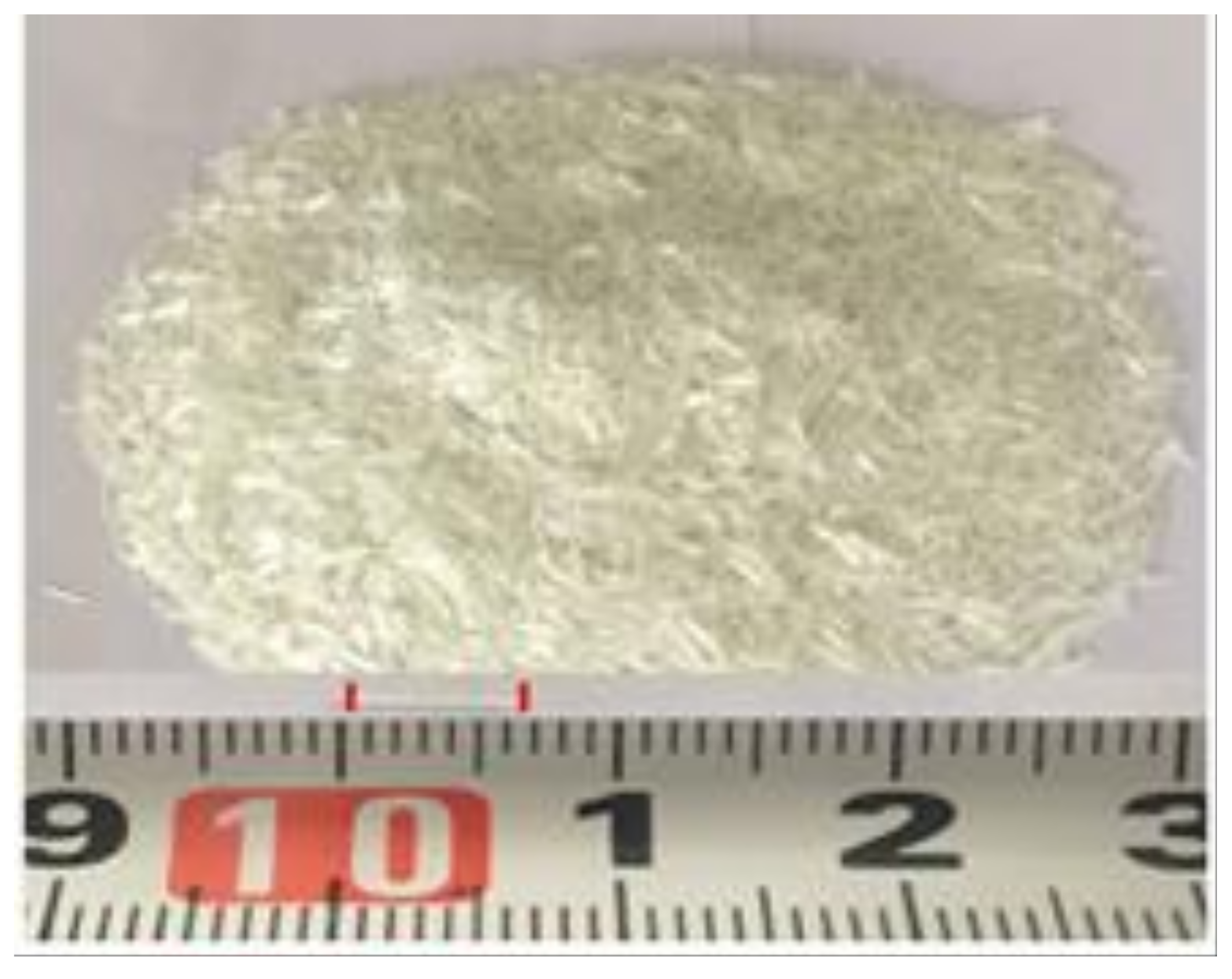
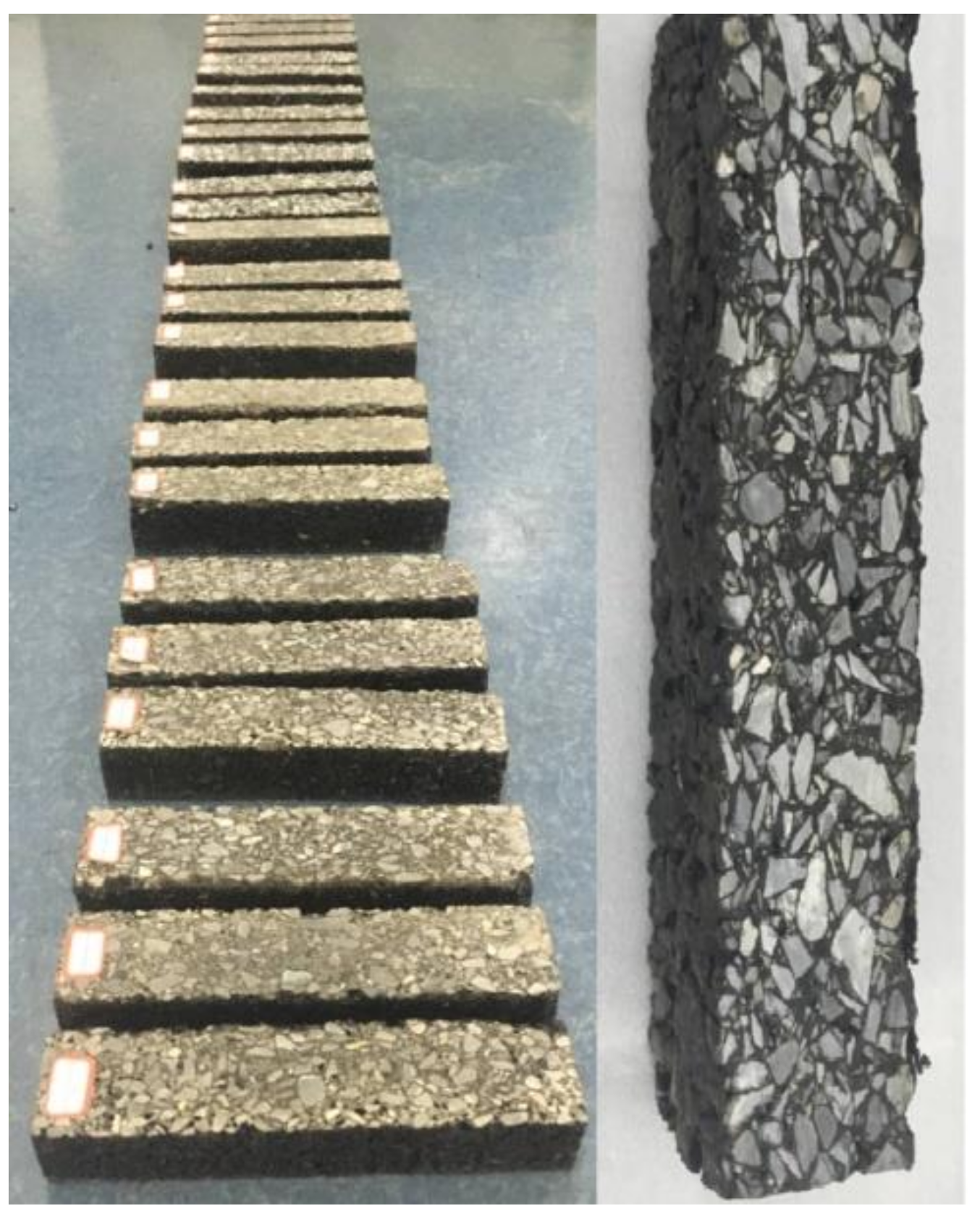
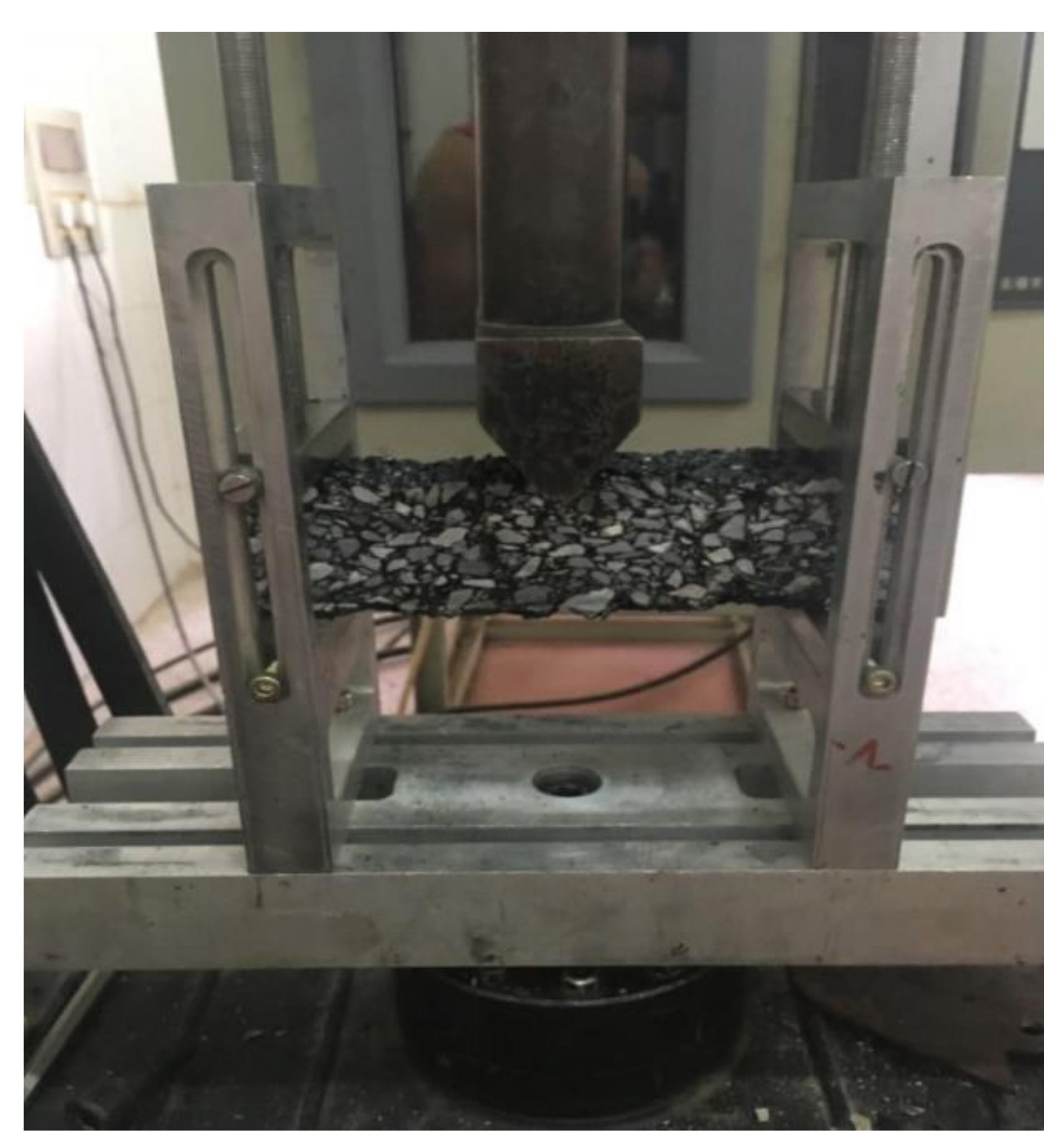
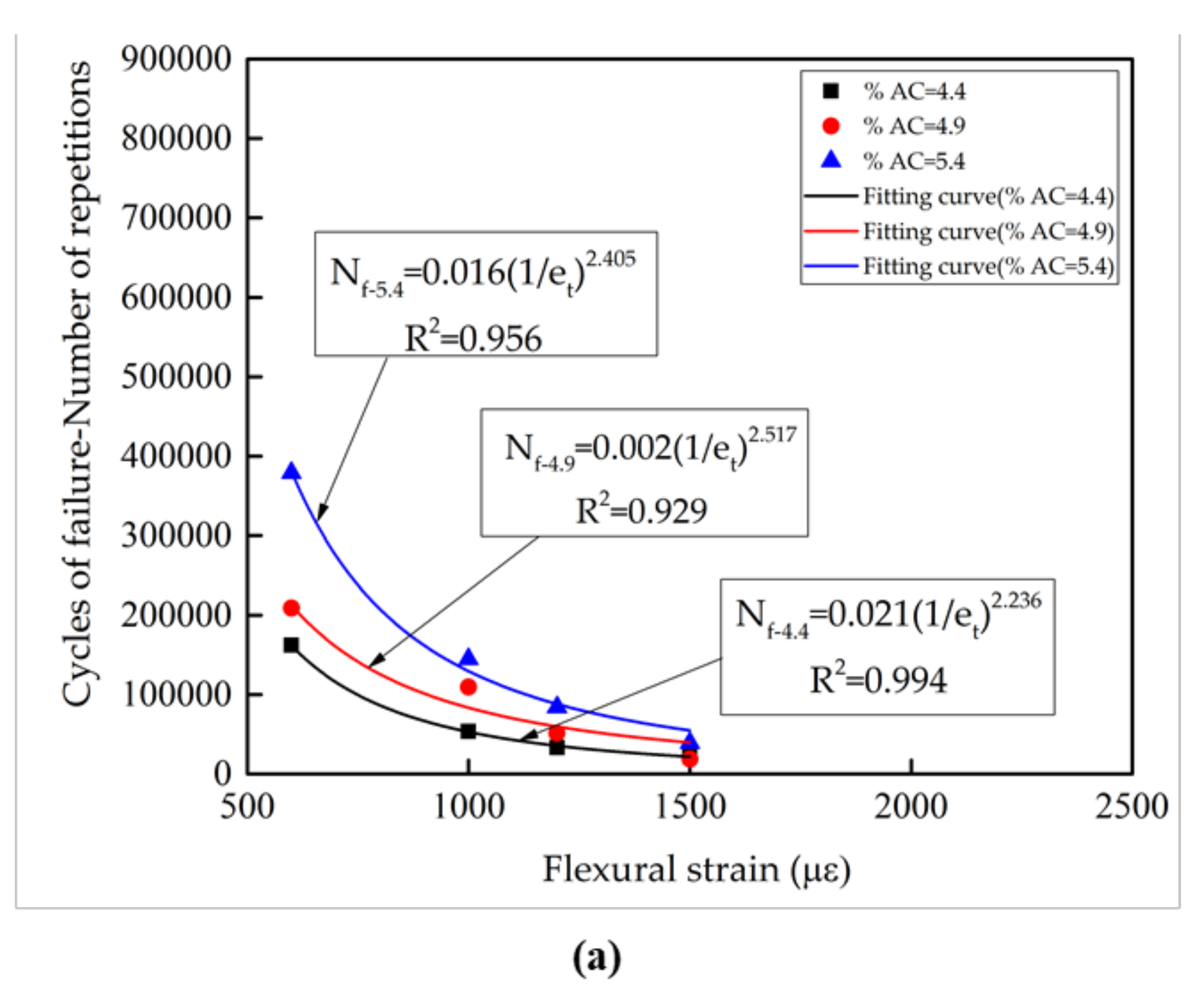

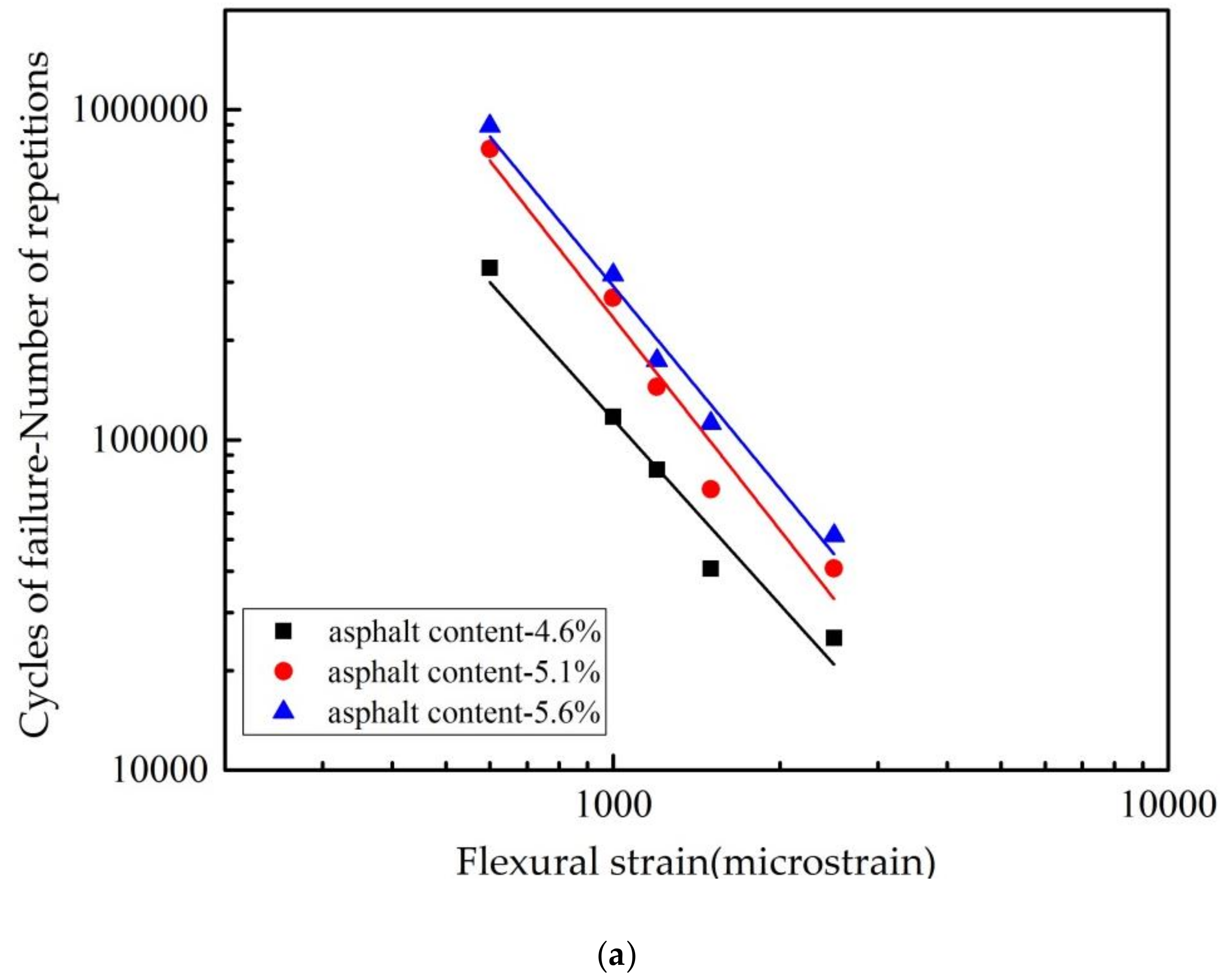



| Test Items | Los Angeles Abrasion (%) | Soundness (%) | Elongated and Flat Particles (%) | Water Absorption (%) | Apparent Specific Gravity |
|---|---|---|---|---|---|
| results | 17 | 1.4 | 8.2 | 1.27 | 2.741 |
| Test Items | Penetration (25 °C, 0.1 mm) | Ductility (15 °C, cm) | Softening Point (°C) | Penetration Index | Viscosity at 60 °C (Pa.s) | Flash Point (°C) |
|---|---|---|---|---|---|---|
| results | 65 | >100 | 48 | −0.24 | 271 | 269 |
| Test Items | Diameter (μm) | Length (mm) | Tensile Strength (MPa) | Percentage of Max. Extend (%) | Initial Modulus (MPa) | Density (g/cm3) | Section Shape |
|---|---|---|---|---|---|---|---|
| results | 13 | 6 | >910 | 8–12 | 17100 | 1.18 | peanut |
| PAN Fiber Content by Weight (%) | OAC (%) | Air Voids (%) | VMA (%) | VFA (%) | Stability (kN) | Flow (0.1 mm) |
|---|---|---|---|---|---|---|
| 0 | 4.9 | 4.1 | 14.2 | 71.1 | 10.4 | 28.7 |
| 0.15 | 5.0 | 3.9 | 13.9 | 71.9 | 12.7 | 32.1 |
| 0.30 | 5.1 | 4.0 | 14.1 | 71.6 | 13.6 | 30.5 |
| 0.45 | 5.3 | 4.2 | 14.1 | 70.2 | 14.2 | 35.9 |
| Fiber Content (%) | Asphalt Content (%) | Volumetric Parameters | Strain Range (µε) | Fatigue Coefficients 1 | R2 (%) | |||
|---|---|---|---|---|---|---|---|---|
| Air Void (%) | VMA (%) | VFA (%) | ||||||
| k1 | k2 | |||||||
| 0 | 4.4 | 7.2 | 16.5 | 56.4 | 600–1500 | 0.021 | 2.236 | 99.4 |
| 4.9 | 6.9 | 17.9 | 61.5 | 600–1500 | 0.002 | 2.517 | 92.9 | |
| 5.4 | 7.5 | 16.6 | 54.9 | 600–1500 | 0.016 | 2.405 | 95.6 | |
| 0.15 | 4.5 | 6.8 | 17.9 | 62.1 | 600–2500 | 1.034 | 1.530 | 96.8 |
| 5 | 7.1 | 18.0 | 60.6 | 600–2500 | 0.323 | 1.861 | 98.7 | |
| 5.5 | 6.5 | 18.7 | 65.3 | 600–2500 | 0.636 | 1.760 | 93.5 | |
| 0.3 | 4.6 | 6.9 | 18.4 | 62.5 | 600–2500 | 0.833 | 1.736 | 97.3 |
| 5.1 | 6.7 | 18.8 | 64.3 | 600–2500 | 0.271 | 1.805 | 95.4 | |
| 5.6 | 7.4 | 18.0 | 59 | 600–2500 | 0.790 | 1.879 | 98.1 | |
| 0.45 | 4.8 | 7.2 | 17.0 | 57.7 | 600–2500 | 0.814 | 1.901 | 93.9 |
| 5.3 | 6.9 | 17.5 | 60.5 | 600–2500 | 1.952 | 1.648 | 95.3 | |
| 5.8 | 6.4 | 18.5 | 65.4 | 600–2500 | 1.039 | 1.812 | 96.2 | |
| Fatigue Equations | k1 | k2 | k3 | k4 | k5 | R2 (%) | F Statistic |
|---|---|---|---|---|---|---|---|
| 5.437 × 10−4 | 1.746 | 1.032 | 2.968 | 9.931 | 95.4 | 254.92 | |
| 0.6355 | 1.369 | 1.216 | 3.200 | - | 81.6 | 113.73 | |
| 8.563 × 106 | 1.598 | 2.164 | - | - | 76.5 | 76.49 |
© 2018 by the authors. Licensee MDPI, Basel, Switzerland. This article is an open access article distributed under the terms and conditions of the Creative Commons Attribution (CC BY) license (http://creativecommons.org/licenses/by/4.0/).
Share and Cite
Wang, H.; Yang, Z.; Zhan, S.; Ding, L.; Jin, K. Fatigue Performance and Model of Polyacrylonitrile Fiber Reinforced Asphalt Mixture. Appl. Sci. 2018, 8, 1818. https://doi.org/10.3390/app8101818
Wang H, Yang Z, Zhan S, Ding L, Jin K. Fatigue Performance and Model of Polyacrylonitrile Fiber Reinforced Asphalt Mixture. Applied Sciences. 2018; 8(10):1818. https://doi.org/10.3390/app8101818
Chicago/Turabian StyleWang, Hui, Zhen Yang, Shihao Zhan, Lei Ding, and Ke Jin. 2018. "Fatigue Performance and Model of Polyacrylonitrile Fiber Reinforced Asphalt Mixture" Applied Sciences 8, no. 10: 1818. https://doi.org/10.3390/app8101818
APA StyleWang, H., Yang, Z., Zhan, S., Ding, L., & Jin, K. (2018). Fatigue Performance and Model of Polyacrylonitrile Fiber Reinforced Asphalt Mixture. Applied Sciences, 8(10), 1818. https://doi.org/10.3390/app8101818




